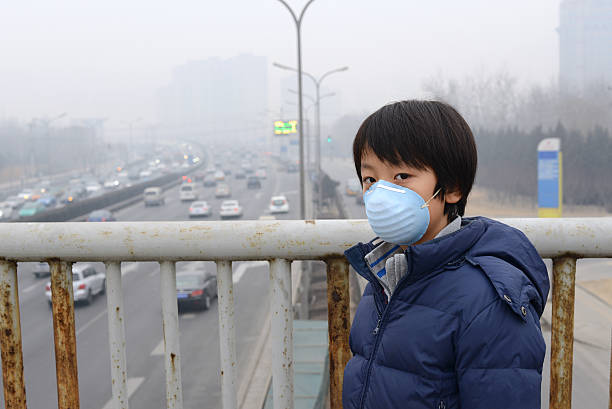How Air Pollution Affects Health of Children

Air pollution affects all of us, including children. In recent years, more research has been done on how air pollution affects children’s health and the results are scary.
In fact, the WHO recently published a 172-page paper on the damaging effects air pollution has on children. They started the paper by saying:
“The evidence is clear: air pollution has a devastating impact on children’s health.”
Yikes!
Pollution is a silent killer that can lead to cancer, and many other chronic diseases, and even impact infant brain development.
Children deaths
The most common causes of child deaths in low- and middle-income countries used to be diarrhea, pneumonia, and malaria. The first two are actually preventable. But these health hazards are being quickly replaced by a far worse, less manageable threat – air pollution.
Today, up to 300 million children live in areas—mostly urban centers—with extremely toxic levels of air pollution, and approximately 2 billion children reside in areas where pollution levels exceed the minimum air quality standards set by the World Health Organization, stated in UNICEF’s latest report on the issue. These are global figures. But it’s easy to assume that two-thirds of the children exposed to bad air quality live in Asia. Which is where the world’s most polluted megacities are located.
If you believe that air pollution causes only respiratory diseases in children. And that your children are safe as long as they don’t develop these illnesses, you are wrong. Pollution is a silent killer that can lead to cancer, and many other chronic diseases, and even impact infant brain development.
How Many Children Are Affected By Air Pollution?
Air pollution is a problem everywhere. A recent WHO study shows that 93% of children globally live in environments with air pollution levels over the recommended guidelines. Even the other 7% of children are still impacted by pollution.
In fact, we recently discussed why the WHO air pollution guidelines are actually not safe and how low levels of pollution can have the biggest health consequences.
Unfortunately, it seems that the situation needs to reach alarming levels first before decision-makers initiate policies to address the problem. Right now, some Asian cities already experience the worst kind of air pollution. In the last few weeks, the population of Delhi had to breathe air that was so bad that schools closed, and doctors advised parents to leave the city with their children. More residents than usual decided to wear face marks to deal with the smog, formed as a result of crop-burning smoke, the Diwali festival fireworks, dust and vehicle emissions, and insufficient action from the city authorities.
Given these facts and the urgency of the problem of air pollution and its long-term impact on our children’s health and their development potential, which will ultimately impact the economy, what can Asian governments do to tackle the issue?
Children Are More Vulnerable to Air Pollution Than Adults
Air pollution is everywhere and affects everyone of all ages. But children are in many ways the most at risk when it comes to air pollution’s negative health effects.
Here’s why:
Their organs (heart, lungs, etc) are still developing
They breathe faster than adults, resulting in breathing in more pollutants
They may spend more time outside playing, exposing them to poor outdoor air quality levels
children spend much time near their mothers while the latter cook with polluting fuels and devices.
Children have a longer life expectancy than adults, so latent disease mechanisms have more time to emerge and affect their health
Air Pollution Affects Children Before Birth
Even while a baby is still in the womb, pollution can affect its health. In fact, there is a strong link between exposure to certain pollutants and birth defects (especially PM, SO2, NOx, O3, and CO).
In particular, studies show exposure to dangerous particulate matter (PM) increases the odds of premature birth and low birth weight. There is also evidence that pollution increases the odds of a stillbirth and the birth of small for gestational age (SGA) babies
Air Pollution’s Effects on Children’s Health
Air pollution is one of the largest threats to a child’s health. In fact, air pollution accounts for 1 in 10 deaths in children under five years old.
Infant mortality.
As pollution levels increase, as do the odds of infant mortality, particularly from exposure to PM and toxic gases.
Neurodevelopment.
Recent research suggests pollution may damage children’s cognitive abilities. Pollution may also influence the development of a variety of behavioral diseases in children, such as autism and attention deficit hyperactivity disorder (ADHD).
Childhood obesity.
Studies have shown a possible link between pollution and childhood obesity. The WHO suggested air pollution increases the risks of cardiovascular and respiratory diseases, heart diseases, and some cancers, which may affect body weight. Pollution may also reduce a child’s metabolism, leading to weight gain.
Lung function.
Children who grow up in more polluted environments are more likely to experience reduced lung growth. This study showed a strong correlation and was even done in California, which has relatively better air quality than much of the world.
ALRI, including pneumonia.
Exposure to PM2.5 has been linked to acute lower respiratory infections (ALRI) such as pneumonia in children.
Asthma.
Exposure to pollution increases a child’s risk of developing asthma and can exacerbate the symptoms of those with asthma.
Childhood cancers.
There is substantial evidence that exposure to traffic-related air pollution is associated with an increased risk of childhood leukemia. Several studies have found associations between prenatal exposure to AAP and a higher risk of retinoblastomas and leukemia in children.
What can we do to fight air pollution and save Children?
Increased Investments
First, increase investments in evidence generation. We must generate better data on air quality and on populations’ health status in cities. Both would need to be correlated in urban data dashboards, which can be presented to decision-makers and shared with civil society. This would also require developing and building consensus on children’s environmental health indicators, with a focus on urban environmental health.
Invest in a good-quality industrial air purifier and commercial air purifier.
Correct Data
Data would also need to be improved from the health service side, including low-cost tools for disease diagnostics (pollution-related respiratory diseases, and brain development issues) and for real-time data sharing of diseases. Based on this improved data availability, local governments should actively disseminate health warnings so that people can better protect themselves, and their children, from air pollution.
Get correct indoor air quality readings with a Co2 Monitor.
Policies
Asian governments should also introduce policies on clean air that require cities to comply with national air quality standards, with tough sanctions for urban centers that don’t comply. A good example is the US Clean Air Act, which mandates national ambient air quality standards and regulates toxic emissions, with stiff penalties for violators. Likewise, governments should allocate financing for healthy urban planning, demanding that cities invest in mass transport systems, green public spaces, and industrial zoning. Singapore is of course the best case study, but Jakarta has started to invest in mass public transportation to reduce pollution from car emissions and in urban greening. Get an air purifier for odor.
Awareness Programs
Awareness-raising programs inform the population about the harmful effects of pollution. By doing so strengthen, they strengthen the popular demand for positive change. Cheap portable C02 measuring devices linked to smartphones share real-time pollution data through social media. This can leverage new forms of information sharing to increase awareness.
It’s also time for Asian governments to do much more to improve overall urban health. Many children don’t have access to good health services in cities and are thus more vulnerable to pollution-linked diseases. Primary health centers need to be able to offer treatment for chronic respiratory diseases, which includes providing oxygen treatment and recognizing that certain diseases are clearly associated with pollution. Infant health, growth, and development depend on both controlling the root environmental causes of poor health and clinical responses.
Finally, start with yourself – be conscious of your own air pollution footprint. Use the best HEPA air purifier for covid Australia.
Bottom Line: How Does Air Pollution Affect Children?
Children are most at risk from the negative effects of air pollution. Especially after COVID-19. These effects include increased odds of birth defects, infant mortality, neurodevelopment issues, obesity, lung growth issues, pneumonia, asthma, and cancers. Unfortunately, the list goes on and nearly every child in the world faces air pollution levels that can be destructive to their health.





